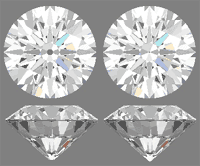Did You Miss The Throwback Thursdays For April 2024?
April is one of our favorites because diamonds are the birthstone, but we always have to say goodbye and head into the colorful blooms of March. These are the TBT…
Sometimes you read that a round brilliant cut has 57 facets, and sometimes 58; the 58th facet is the culet.
A diamond behaves as a window if opposing facets are parallel, and this is exactly what happens if the culet is too big, because the culet is parallel to the table. The result is that you can see right out the ‘hole’ the culet appears to make in the center bottom of the diamond. If you have ever seen a large old cut diamond you probably know what we mean.
The culet size is listed on a cert and your diamond’s culet should be pointed (no culet), very small, small or medium because these are not visible to the naked eye.
Large to extremely large culets may be visible to the naked eye and can look like an inclusion.

Large (left) and Medium (right) Culet